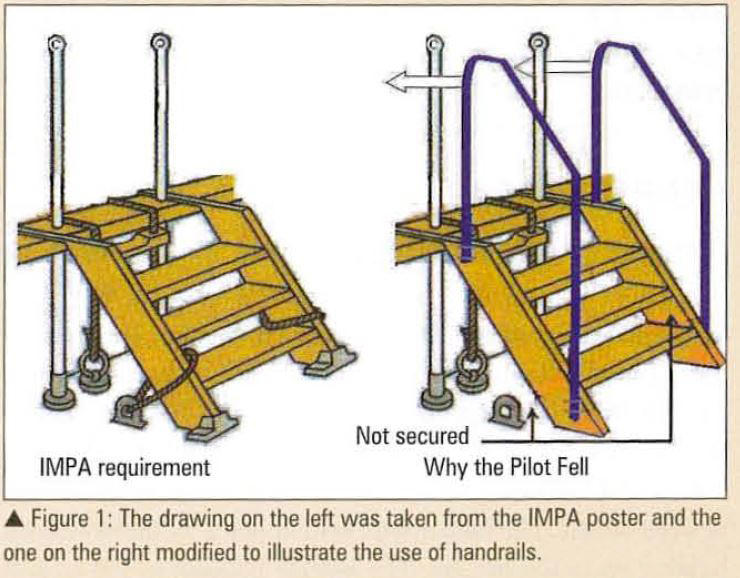200547 Pilot Fell Overboard
Pilot Fell Overboard
MARS Report 200547
The incident occurred a few years back whilst departing port on a general cargo ship. The ship was a regular caller at this port and, being loaded to her (T) marks, the freeboard was low. The Pilot boarded at sea via the pilot ladder. He appeared to be in quite a hurry to get on board and started climbing up the pilot ladder as soon as it was confirmed to him by the 2nd Officer on deck that it was secured. The 2nd Officer later stated that the bulwark stepladder (without it's railings) was placed in a hurry as the pilot had already started to climb. It had not been fastened from the bottom but held in place by the 2nd Officer standing on the bottom step. Since he assumed it would be removed shortly (the river passage being about 3 hrs) he had not attempted to secure it further.
Once the Pilot came on the bridge, the 3rd Officer on the bridge received confirmation from the pilot that he would be getting off from the same side so that it was agreed to leave the ladder as it was. The usual practice, once the ladder had been rigged for the Pilot to disembark, was that the 2nd Officer checked the ladder and reported to the 3rd Officer on the bridge that the ladder had been checked. On this occasion, the 3rd Officer, having seen the 2nd Officer near the Pilot ladder, assumed that the ladder had been checked and had not sought confirmation from him. When the Pilot was getting ready to disembark, the Master asked the 3rd Officer whether the pilot ladder was checked and the reply was 'Yes'.
At the time of the pilot getting off, another ship had already arrived at the pilot boarding position and was waiting for our pilot to be transferred. Usually, a second check is made by the 3rd Officer but on this occasion the pilot, being in a hurry, had brushed ahead past the 3rd Officer, got on to the bulwark ladder and started to climb out. On reaching the top of the bulwark, he turned to face the shipside, held onto the hand rails on the bulwark ladder (instead of the Man-Rope stanchions) and stepped on to the pilot ladder. Since the bulwark ladder had not been made fast at its bottom (see figure), when his weight came on to the bulwark ladder hand rails, due to the pivoting action, the bottom of the Bulwark ladder began to tip over, with the pilot hanging onto the bulwark hand rail. When the bulwark ladder began to tip over, the 3rd Officer tried his best to hold onto it's bottom.
However, the leverage caused by the overhanging weight of the pilot caused it only to reduce it's tipping momentum, resulting in the pilot losing his grip and falling onto the Pilot Boat.

It was very fortunate that the vessel had very low free-board and that the pilot boat was a small tug, so the pilot, falling only about a meter or so in height, escaped with minor bruises. The pilot went into the boat cabin, called back on his VHF and said that he was OK and for the Master not to worry. The vessel being a regular caller and pilots being friendly, no complaint was made by the pilot to the authorities.
Lessons learnt
On the above vessel, I was the Master. Since then, in every vessel I sail, I check the bulwark ladder and insist that the IMPA recommendations (Poster) be strictly followed where there is no railing for the bulwark ladder. (The figure on the left was taken from the IMPA poster and one on the right modified to illustrate use of handrails). Although I insist that the ladder is secured from the bottom and a second check is made of the ladder prior to embarkation/disembarkation of the pilot. There is no chance of the ladder tipping over if there are no hand rails fixed onto the bulwark ladder, even if the ladder is not secured at the bottom.
Another fault I have found in some ships is that, at the bottom of the man-ropes, a 'Monkey's fist' (a thick ball of rope) is made. This is also a dangerous practice as if, whilst the pilot is holding onto the man ropes, the pilot boat pitches and the gunwale slides down along the shipside with the manrope(s) between the gunwale and the shipside and this 'ball' gets trapped, the manrope can get stretched and the pilot's knuckles can get caught between the rope and the shipside, causing injury to his knuckles and maybe even causing him to lose his grip. (A Japanese Pilot advised me against this practice). Again - Strictly follow the IMPA recommendations.
A third fault I have found is that the heaving line is made fast to the life buoy with the self igniting light, instead of the heaving line and the life buoy with the self igniting light being kept separate (as recommended by IMPA).
